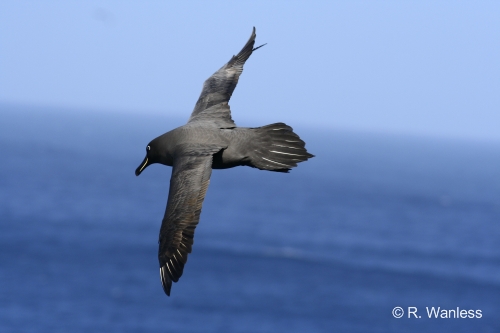Yves Cherel (Centre d'Études Biologiques de Chizé, France) and colleagues writing in the journal Ecography, have looked at where non-breeding albatrosses in the southern Ocean go based on stable isotope values.
The paper's abstract follows:
"Albatrosses are among the world's most endangered seabirds. Threats during the nonbreeding period have major impacts on their population dynamics, but for most species, detailed information on distribution and ecology remains essentially unknown. We used stable isotope values (δ13C and δ15N) in feathers to infer and compare the moulting (nonbreeding) habitats of 35 populations that include all the 20 species and subspecies (444 individuals) of albatrosses breeding within the Southern Ocean and in fringing subtropical waters. Isotopic values together with a review of available information show that the 20 albatrosses can be categorized into three groups depending on their favoured moulting grounds: 12 (60%) taxa forage primarily in warm neritic waters, six (30%) in northern oceanic waters and two (10%) in oceanic waters of the Southern Ocean. Stable isotopes indicate that habitat preferences during the nonbreeding period vary much less among different breeding populations in some species (wandering, Salvin's, grey-headed and light-mantled sooty albatrosses), than others (black-browed, Indian yellow-nosed and sooty albatrosses). The major finding of our isotopic investigation is that the great majority of albatrosses spend the nonbreeding period outside the Southern Ocean, with only three species (and in the sooty albatross, just one of the breeding populations) favouring oceanic subantarctic waters at that time. Hence, the study highlights the overwhelming importance of subtropical waters for albatrosses, where the birds are known to interact with human activities and are more likely to be negatively affected by the diverse range of fisheries operating in both neritic and oceanic waters."

Sooty Albatross at sea. Photograph by Ross Wanless
Reference:
Yves Cherel, Y., Jaeger, AS., Alderman, R., Jaquemet, S., Richard, P. Wanless, R.M., Phillips, R.A. & Thompson, D.R. 2012. A comprehensive isotopic investigation of habitat preferences in nonbreeding albatrosses from the Southern Ocean. Ecography. DOI: 10.1111/j.1600-0587.2012.07466.x.
John Cooper, ACAP Information Officer, 18 August 2012

 English
English  Français
Français  Español
Español